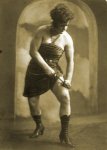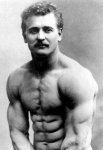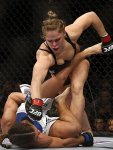JonWake
First Post
More gold: Forgotten Strong Women- Katie Sandwina
http://thehumanmarvels.com/878/sandwina-woman-of-steel/strong

She even took a challenge from the bodybuilding legend Eugene Sandow.

Minerva
http://thehumanmarvels.com/124/minerva-and-charmion-strongwomen/strong

And while we're talking about badass warrior women, let's not forget Rhonda Rousey.

http://thehumanmarvels.com/878/sandwina-woman-of-steel/strong

"Kate’s natural strength came from her lineage and physical proportions. In adolescence Kate stood just over six feet tall and weighed 187 pounds. She honed her natural abilities through intensive exercise and in her heyday was known for her bulging 17 inch biceps and 26 ½ inch thighs. Kate initially displayed her muscular girth to the paying patrons of the circuses her father contracted with. She was initially a wrestler of men and famously offered 100 marks to any man who could best her. According to legend, she never lost her bet and even gained a husband after soundly thrashing a young man by the name of Max Heymann. Heymann thought tussling with a woman would be a rather delightful way to earn 100 marks. But by his own account he recalled only entering the ring, a blue sky and being carried away from the ring by Kate like a prize. The couple remained married for 52 years."
She even took a challenge from the bodybuilding legend Eugene Sandow.

"Sandow was a man carved of granite. Indeed, he had sculpted his body to resemble the statues of the old gods he saw as a child. He was considered the most physically gifted man in the world and Kate was certain that she had made a grave error in judgement. Still the contest began as Kate began lifting increasingly heavy weights and Sandow, subsequently, lifted those she was done with. This went on for some time, until Kate hoisted the unholy sum of 300 pounds above her head with one hand. Sandow could only raise the weight to his chest and Kate was declared the winner. It was shortly thereafter that Kate adopted the name Sandwina – a feminine derivative of ‘Sandow’ – though it is unclear if this action was a tribute or a taunt."
Minerva
http://thehumanmarvels.com/124/minerva-and-charmion-strongwomen/strong

In her displays she demonstrated her strength by breaking horseshoes with her hands, breaking steel chains by expanding her chest, and playing catch with a 24 pound cannon ball. She was capable to lift a stone weight of 360 lbs with a single finger thrust through a lifting ring. Furthermore, The Guinness Book of Records recognized Minerva as having lifted the greatest weight ever by a woman. At the Bijou Theatre in Hoboken on April 15, 1895 Josephine Blatt lifted 3,564 lbs in a hip-and-harness lift. With that superhuman lift, Josephine Blatt nearly achieved the mythical status of her namesake.
And while we're talking about badass warrior women, let's not forget Rhonda Rousey.

